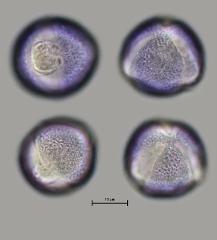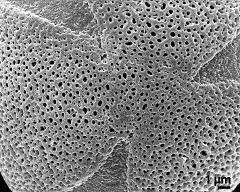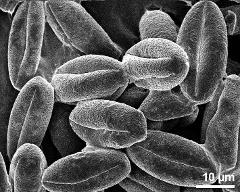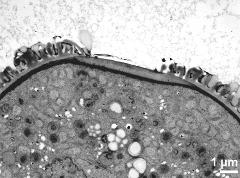Digitalis lutea
Taxonomy: Angiospermae, Lamiales, Plantaginaceae, Digitalis
Links: http://flora.nhm-wien.ac.at/Seiten-Arten/Digitalis-lutea.htm
Published: 2020-12-15
Pollen Description
Shape, Size and Aperture
pollen unit: monad, dispersal unit and peculiarities: monad, size (pollen unit): small (10-25 µm), size of hydrated pollen (LM): 21-25 µm, shortest polar axis in equatorial view (LM): 21-25 µm, longest polar axis in equatorial view (LM): 21-25 µm, shortest diameter in equatorial or polar view (LM): 21-25 µm, longest diameter in equatorial or polar view (LM): 21-25 µm, pollen class: colporate, polarity: isopolar, P/E-ratio: -, shape: spheroidal, outline in polar view: circular, dominant orientation (LM): oblique, P/E-ratio (dry pollen): prolate, shape (dry pollen): -, outline in polar view (dry pollen): lobate, infoldings (dry pollen): aperture(s) sunken, aperture number: 3, aperture type: colporus, aperture condition: colporate, tricolporate, aperture peculiarities: aperture membrane psilate
Ornamentation and Structure
LM ornamentation LM: reticulate, nexine: -, sexine: -, SEM ornamentation SEM: microreticulate, suprasculpture SEM: -, TEM tectum: eutectate, infratectum: columellate, foot layer: continuous, endexine: compact-continuous, intine: monolayered, wall peculiarities: -, supratectal element: -
Miscellaneous
pollen coatings: pollenkitt, reserves in cytoplasm: lipids, cell number: 2-celled, Ubisch bodies: present
Author(s) of diagnosis: Halbritter, Heidemarie; Weber, Martina; Auer, Waltraud
Pictures
Picture legend
- hydrated pollen - fresh, glycerine, unstained, photographer: Auer, W.
- hydrated pollen - fresh, glycerine, ruthenium red, photographer: Auer, W.
- hydrated pollen - fresh, glycerine, ruthenium red, photographer: Auer, W.
- polar view - fresh, rehydrated (water) & critical point dried & sputter coated with gold, photographer: Halbritter, H.
- equatorial view - fresh, rehydrated (water) & critical point dried & sputter coated with gold, photographer: Halbritter, H.
- aperture - fresh, rehydrated (water) & critical point dried & sputter coated with gold, photographer: Halbritter, H.
- exine surface - fresh, rehydrated (water) & critical point dried & sputter coated with gold, photographer: Halbritter, H.
- polar area - fresh, rehydrated (water) & critical point dried & sputter coated with gold, photographer: Halbritter, H.
- dry pollen grains - dry, sputter coated with gold, photographer: Halbritter, H.
- cross section of pollen grain - fresh, glutaraldehyde & osmium & potassium ferrocyanide, uranyl acetate & lead citrate, photographer: Svojtka, M.
- pollen wall; infratectum filled with pollenkitt (asterisks) - fresh, glutaraldehyde & osmium & potassium ferrocyanide, uranyl acetate & lead citrate, photographer: Weber, M.
- aperture - fresh, glutaraldehyde & osmium & potassium ferrocyanide, uranyl acetate & lead citrate, photographer: Weber, M.
- vegetative nucleus (asterisk) and generative cell - fresh, glutaraldehyde & osmium & potassium ferrocyanide, uranyl acetate & lead citrate, photographer: Weber, M.
Literature
- (1977) The pollen morphology of plants in Ankara region IV. Scrophulariaceae. Commun Fac Sci Univ Ankara Ser C2 Bot 21: 131-143
- (1989) Palynological studies in the family Scrophulariaceae from Jordan and Iraq. Pollen et Spores 31: 203-214
- (1989) Pollen morphology of the Orobanchaceae and rhinanthoid Scrophulariaceae. Grana 28: 1-18
- (1981) Morphologie du pollen et embryogenése chez Digitalis purpurea L. et D. thapsi L. Rev Roum Biol, Biol Vég 26: 117-122
- (1939) Die Pollenkörner der in Deutschland wild wachsenden Scrophulariaceen. Ber Deutsch Bot Ges 57: 108-121
- (1938) Sur le pollen de l'hybride de Digitalis lutea L. X Digitalis purpurea L. Bull Soc Bot France 85: 584-586
- (1968) Studies in the family Scrophulariaceae - II. J Palynol Lucknow 4: 91-97
- (1998) Preparing living pollen material for scanning electron microscopy using 2,2-dimethoxypropane (DMP) and criticalpoint drying. Biotechnic Histochem 73: 137–143
Copyright and Citation
Cite this publication as:
Halbritter H., Weber M., Auer W., Svojtka M. 2020. Digitalis lutea. In: PalDat - A palynological database. https://www.paldat.org/pub/Digitalis_lutea/304510;jsessionid=F44FFC028121D288B459051A15F123A2; accessed 2024-11-01













